July 18, 2017
The Weekend Effect, by Katrina Onstad
 The very best phone I ever had was a little red flip phone which was ahead of its time in 2004, but this was Japan where all the phones were from the future. The phone fit perfectly inside my hand, and I remember the grip of it, the ringtone, how coloured lights on the outside lit up when it rang, and mostly what I remember is standing on the train platform at the beginning of another week at work and sending a text to Stuart (who was not yet my husband) that would say something like, “Thank you for another excellent weekend.”
The very best phone I ever had was a little red flip phone which was ahead of its time in 2004, but this was Japan where all the phones were from the future. The phone fit perfectly inside my hand, and I remember the grip of it, the ringtone, how coloured lights on the outside lit up when it rang, and mostly what I remember is standing on the train platform at the beginning of another week at work and sending a text to Stuart (who was not yet my husband) that would say something like, “Thank you for another excellent weekend.”
Part of this is that we were living abroad, and I’d been doing so for a few years by then, which had got me into the habit of making the most of my time in a place that wouldn’t be home forever. Part of it too was that we had very few holidays and long workdays, and we were living in a culture that draws a firm line between work and leisure, although with the latter pursued with the same regimented approach as the former. There is nothing casual about leisure in Japan—pursuing hobbies seemed to be more important than actually having passion for the hobbies one is pursuing. While we were living in Japan, I took up yoga, French, cycling, pickling, hiking, and breakdancing, all with varying degrees of failure, and actually contemplated spending a week in silence at a Buddhist retreat, but couldn’t get the time off for that. And the same determined sense of openness and possibility permeated our weekends, which were not actually the weekend, but fell on Thursday and Friday, if I recall correctly. “We take train trips like they’re vitamin pills,” I noted in a poem I wrote about that period, and it definitely helped that the trains were cheap. And so off we’d go on our days off on various adventures, always taking care to return with omiyage, as well as a story to tell.
And so this is the ethos we’ve brought with us through the years, a serious approach to the weekend. I figured that in her new book, The Weekend Effect: The Life-Changing Benefits of Taking Time Off and Challenging the Cult of Overwork, Katrina Onstad would be preaching to the choir, but I picked up the book anyway because I’ve been a fan of Onstad’s writing for as long as I’ve loved weekends. “Weekends are my religion,” I wrote in an instagram post to this effect, somewhat sacrilegiously, I figured, but then I was stirred to encounter in the book on Page 16, “The outline of the weekend is etched in the sacred.” Most religions, Onstad writes, exhort a day of rest—Muslims pray and congregate on Fridays, Jews on Saturday and Christians on Sunday. Perhaps I’m more religious than I know.
Onstad begins her book with history, with the weekend as a labour issue whose origins are much more recent than I would have imagined. Weekends are also an issue of class and consumption, and she explores the idea of leisure and its own changing history. And leisure remains much of the focus of the rest of the book, as Onstad considers what might give a weekend meaning—connection, volunteerism, rest, religion, sports, nature—and those things that might detract from it—shopping, housework, the internet, binge-watching TV. Onstad travels around North America speaking to people who are reinventing the weekend, pushing its limits and making the most of their time off, to demonstrate how the rest of us might do a better job of doing so. And even for me, someone pretty weekend-devout, there was lots of food-for-thought here about how we might make better use of ours, which matters, because—as Annie Dillard wrote—of course, how we spend our days is how we spend our lives.
We’ve got two things on our side in our family—the first is that I work from home with flexible hours, which means that I can get our household chores out of the way during the drudgery of Monday to Friday 9-5 (although this also means that I’ve spent plenty of time on the weekend huddle over my laptop on a deadline, but sometimes that the price you pay). The second is that our children are not particularly sporty and even if they were, we don’t have a car or the inclination to spend those precious weekend days ferrying them to hockey arenas and gymnastics tournaments. There is an upside to the fact that no one in our household possesses the physical prowess to turn a cartwheel, and so it goes. This winter, we didn’t sign our children up for anything, which meant that we had free Saturdays—for things like the neighbourhood community cleanup, and marching with placards on International Women’s Day, and it gave me a real appreciation for the possibilities of openness and where a single can take you—or even two.
July 13, 2017
Nova Scotia Dreams
We went to Nova Scotia for the same reason we go anywhere, which is to say that it was bookstore-related. And also that I have a very indulgent family, it is true, who are willing to come along on these bookshop adventures, even if they’re not quite as crazy about bookshops as I am (and to be half as crazy about bookshops as I am is a lot of crazy to ask of anybody).

But the thing about bookshops is that are frequently located in interesting places, which makes bookshop adventures about more than just the bookshop. They are also about snacks, and lunch, dinner, croissants, good coffee, playgrounds, picnics, toy stores, and more snacks. In this case, they were also about the ocean, playing on gorgeous beaches, seeing big ships in Halifax Harbour, getting so close to PEI that the road turned red, seeing a bear and a deer by the side of the road on the very same day, collecting seaglass, getting sunburned, and eating lobster and all the seafood chowder, and getting a write-up in the Tatamagouche Light.
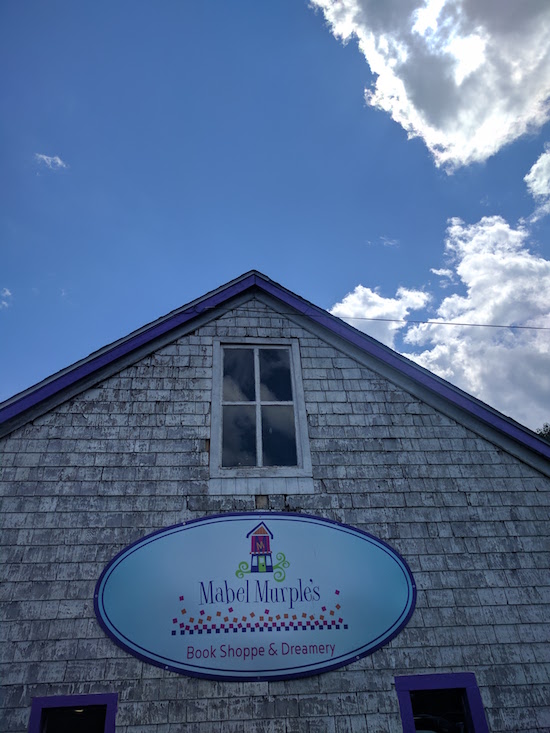
We went to Nova Scotia because Sheree Fitch had opened a bookshop there, Mabel Murple’s Bookshoppe and Dreamery, in River John, and also because the rest of my family is made up of new Canadians (i.e. nobody has been a Canadian for more than a handful of years) and we wanted to explore a new part of the country. And so as the rest of the country was celebrating 150 years of settler-colonialism, we were up in the sky above it all, which seemed a lot better than the alternative. We also got to see the giant duck from the air.
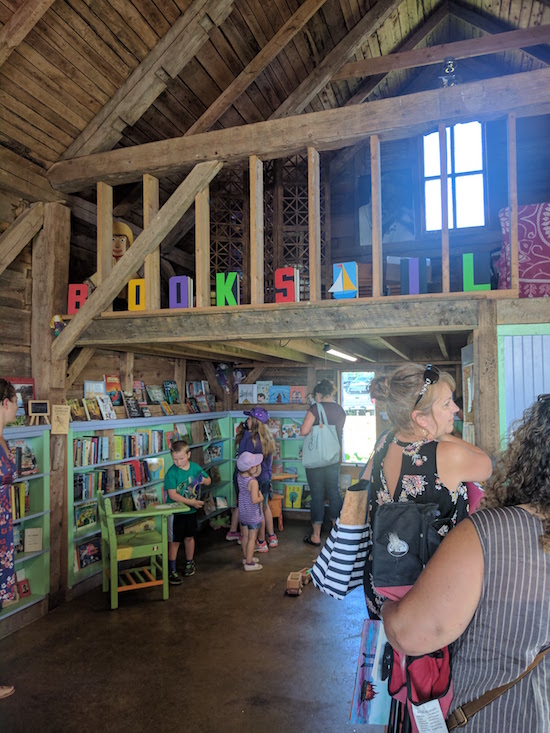
Mabel Murple’s was built in an old granary, and it was full of colour and books and magic. The books were terrific, the vibe incredible, and the way the sun poured in through those windows. The carpentry was the handiwork of Fitch’s amazing husband, Gilles Plante, and I suspect it was Sheree who supplied the dreams and whimsy…and the colour. The place was enchanting, and while my children have seen a lot of bookshops in their time, even they were impressed. Outside the shop in the sand, someone had scattered tiny purple sparkles, and Harriet and Iris were busy trying to capture some. Opening Day was also the Wordplay festival, so we sat down on our picnic blanket and took in music and readings, plus there were sheep, and a goat, horses and a donkey, a shed that had been painted purple and transformed into Mabel Murple’s house and we were all quite delighted as we peered inside.
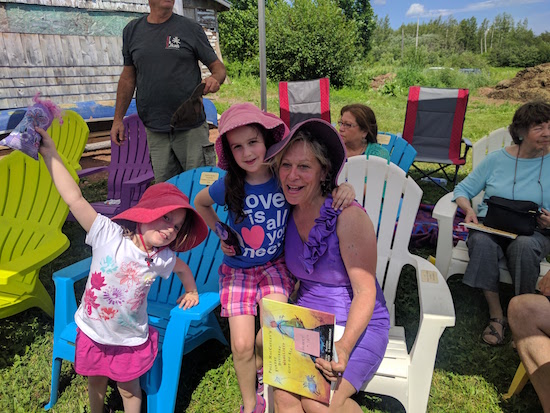
And then we got to meet Sheree, who we met for the first time when Iris was an infant and Harriet was four (remember that?). Sheree, who has the most remarkable ability to make a person feel like the most special person in the world. And there were hundreds of there who came to see her, and I think we all came away feeling exactly that way. 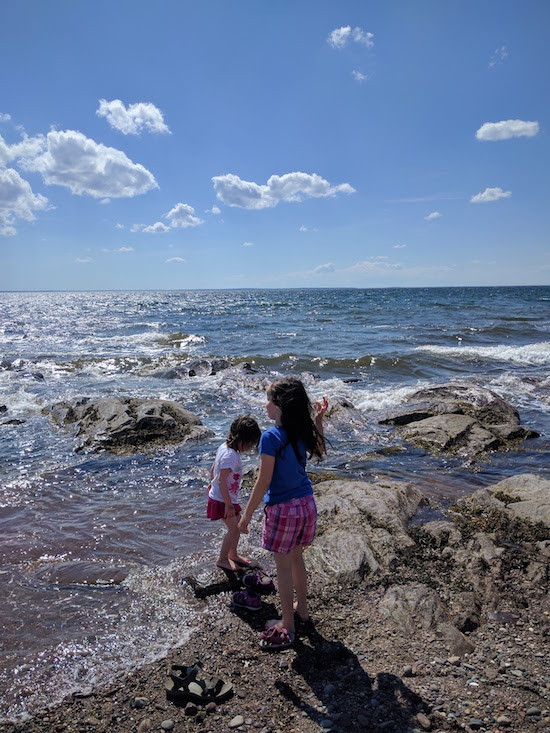
And then we drove up the road from Mabel Murple’s to Cape John, because we hadn’t properly seen the sea yet. Later we’d discover that it’s one of the best beaches in Nova Scotia for finding sea glass. We found some lovely pieces, but mostly just revelled in the goodness of putting our feet in the ocean, feeling the sand and stones beneath them. The sparkles on the wave, those clouds, and that sky. It was one of those holiday moments where we’re all thinking, “This is everything everything everything.”
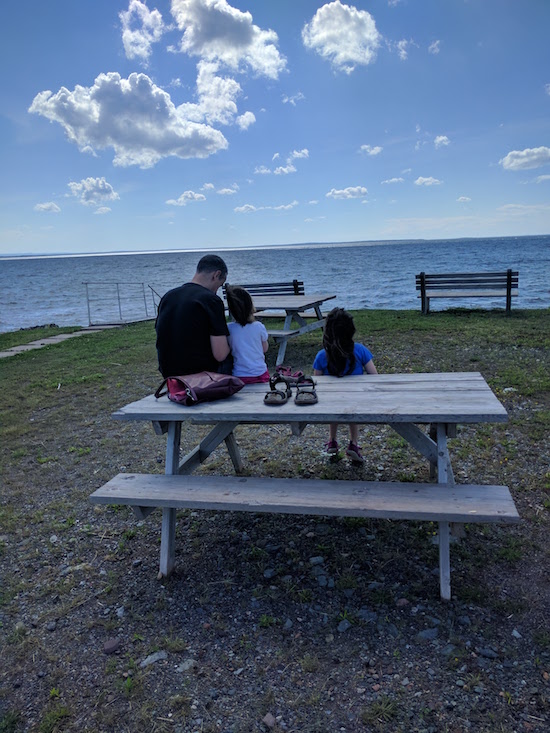
We were fortunate to get the use of friends’ beautiful home in the North End of Halifax for our home base during our visit, and we explored the city with such pleasure. Fantastic meals, fun by the harbour, the Africville Museum, the Discovery Centre, the Farmers’ Market, the Central Library, Woozles and The Bookmark, and so much more. 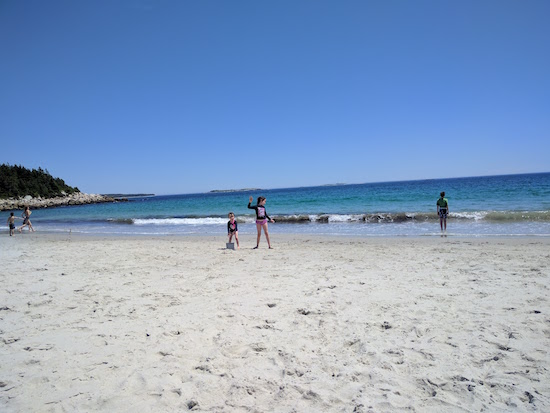
We spent a wonderful afternoon at Crystal Crescent Beach, with white sand and blue water that could almost trick you into believing that you were in the tropics—except the water was cold. 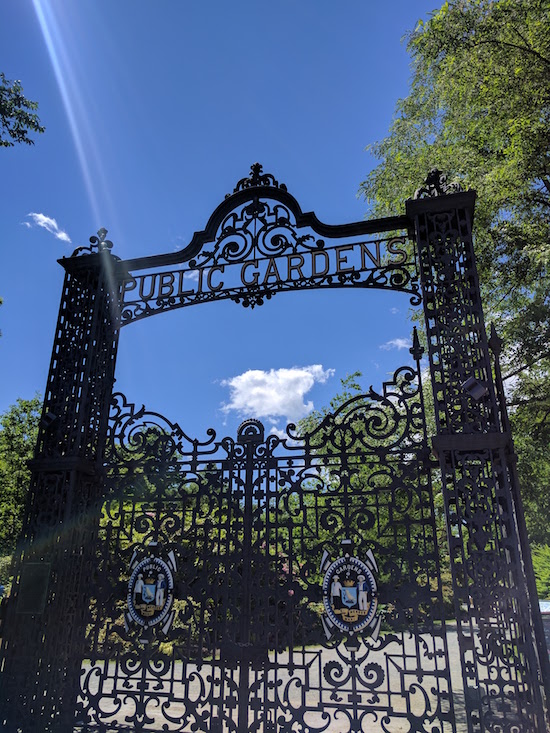
We loved the Public Gardens, which reminded us all vividly of the book Mary Poppins in the Park, which we read not so long ago, because there was a park keeper and bylaws and everything. It was pretty magic and we got ice cream, and were given a tour by Rohan Maitzen, who I’ve been a fan of online for awhile now and it was very nice to meet properly in real life. 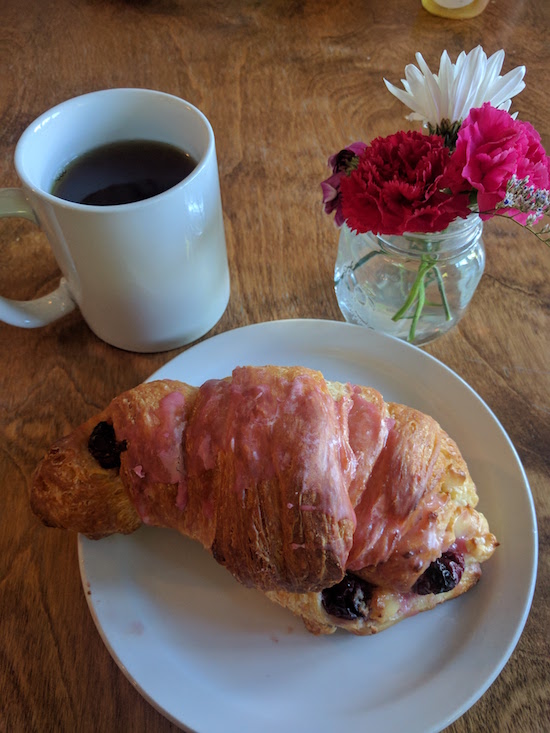
Tragedy struck on our final morning in Halifax—we ran out of cereal (oh no!) and therefore had to have our breakfast at Two If By Sea in Dartmouth, whose croissants we’d tried early in the week and they were so extraordinary that we had to make a return trip. Sour cherry cheese, guys. It was seriously the most delicious thing ever. 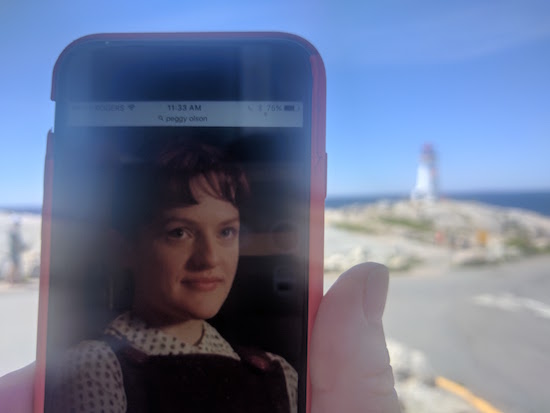
Someone threw up on the way to Peggy’s Cove, as you do. 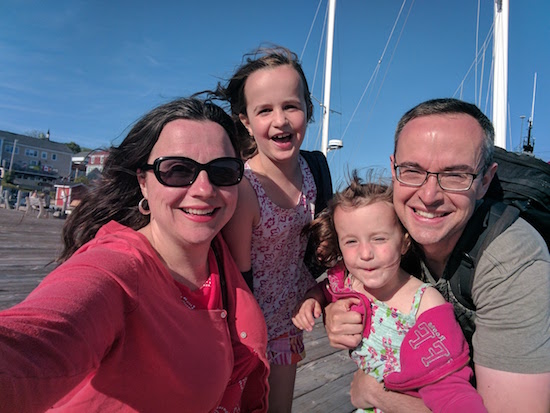
And then we were in Lunenberg! UNESCO World Heritage Site, BABIES! 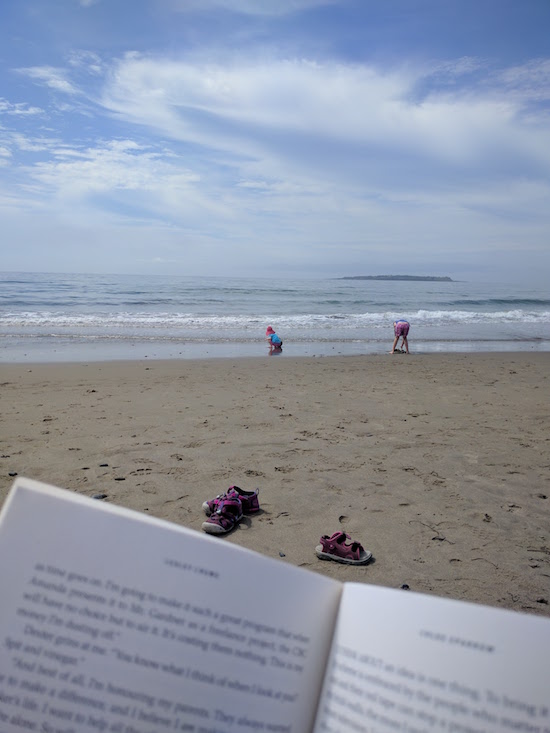
There was lobster dinner to die for, and then we spent the next morning with Hirtles Beach to ourselves (the puke bucket subs in nicely for a sand pail, FYI) which was so magnificent (even with grey skies and shrouded in fog) that we felt like we were in a story. 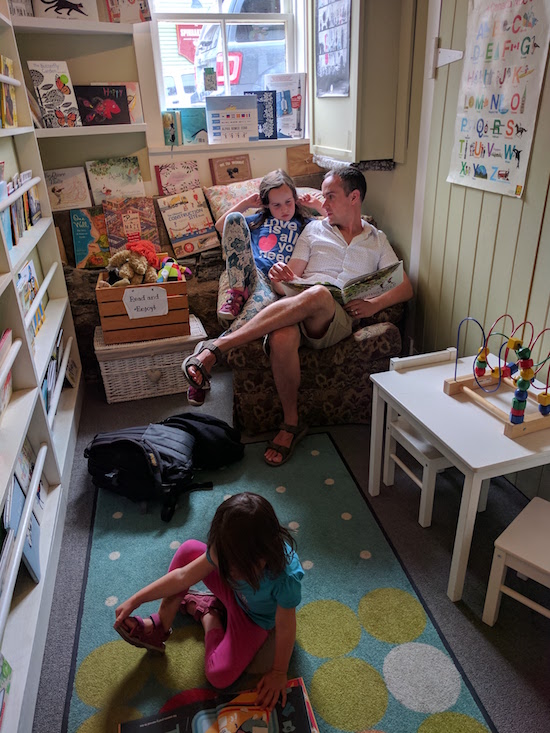
And speaking of stories, we got to visit Lexicon Books, where I’d be doing a reading that evening. I’d seen photos of the store on social media, but they did not even come close to how great the space was in real life, and how good the books were. 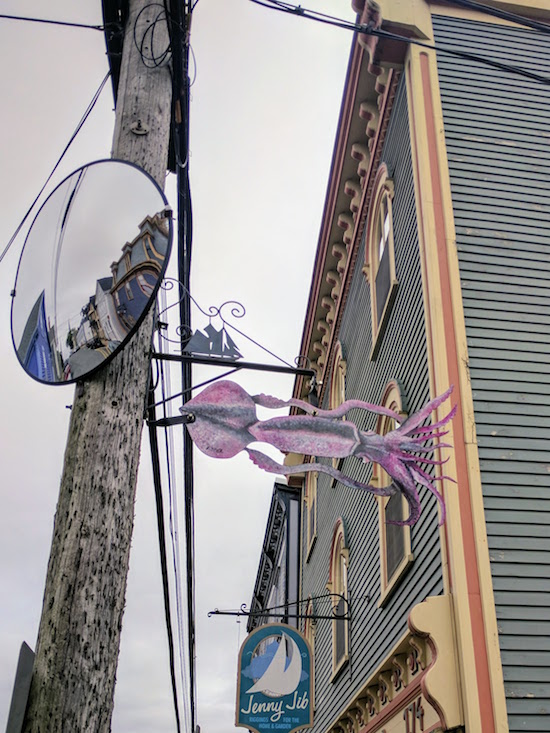
So there was more, squids in the street, and our excellent B&B, and incredible things to discover ’round every corner in Lunenburg.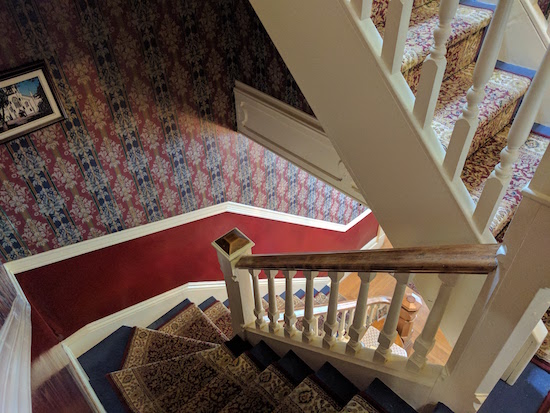
The reading that night was terrific, and I was pleased to be there with Johanna Skibsrud and Rebecca Silver Slayter—and I had a good time reading Rebecca’s novel In the Land of the Birdfishes for the rest of the weekend. 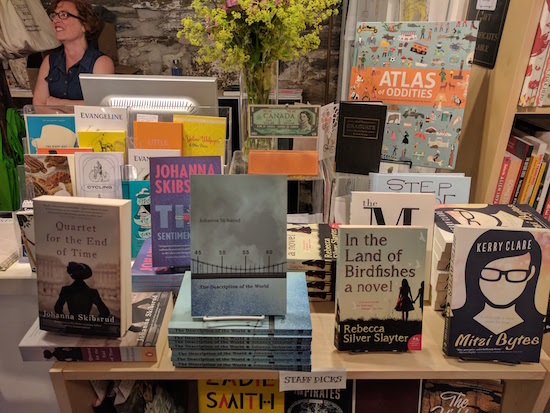
We stopped in Mahone Bay on our way to the airport, to get sandwiches and oatcakes for the plane, and for one last bowl of chowder, not to mention a quick look for sea glass in search of some elusive lavender glass. Which was not meant to be. Next trip, I guess? I hope so.
Quick! Somebody open up another bookshop….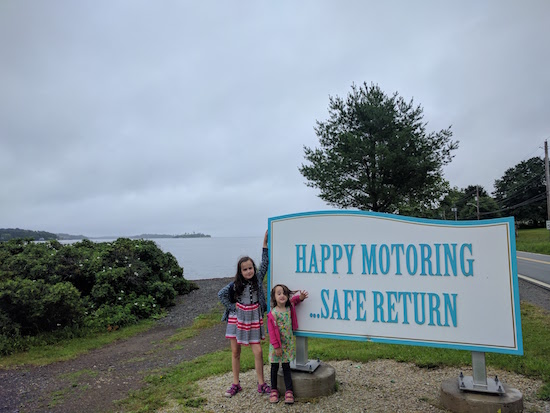
July 11, 2017
Mitzi Bytes in the World—and in the Sun
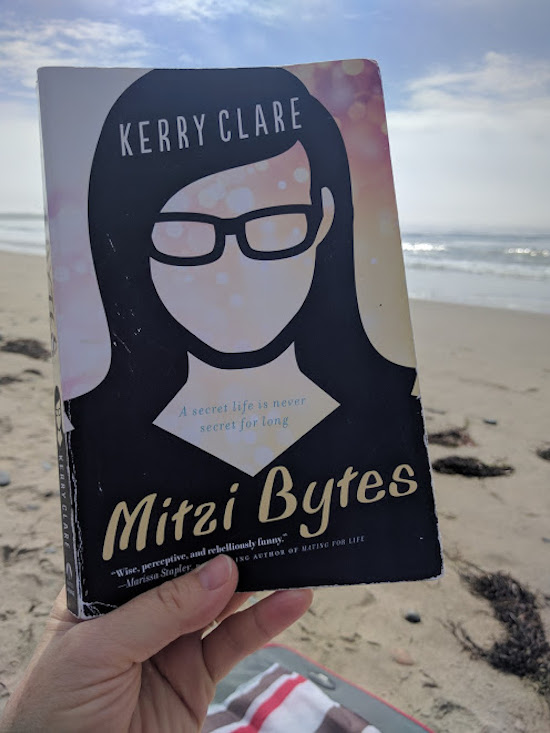
“You’ve got to have a long view,” is a thing I told a writer last year who was troubled that her book had not been the explosive sensation she’d been hoping it would be. From a reader’s perspective, this seems obvious—there is no such thing as a book best-by date and the number of times it’s taken me ages to finally pick up a book I’d fall in love with is kind of preposterous. But for a writer, there is pressure, for a book to be a hit the moment it’s out of the gate, and while it’s true that there is a limited window in terms of media coverage and award eligibility and things like that, these aren’t actually the literary connections that matter. And now I keep having to deliver my own advice to myself, to remember that the life of a book is long, serendipitous, sometimes subtle, and always surprising. And while my book is now old news as new releases go (literally, so last-season), it’s continuing to have adventures out in the world and I find this so delightful.
And first, if you’re looking to come along on a Mitzi Bytes adventure, tickets are still available for my event at the Lakefield Literary Festival this weekend with Zoe Whittall and Marni Jackson. (I am also teaching a blogging workshop on Saturday morning.) Having loved both Marni and Zoe’s books last summer, it’s especially exciting to be appearing with them on Friday—for it’s a long way from the screened-in porch where I devoured Zoe’s book to a seat alongside her on the festival stage. (!!)
![]()
Last Friday, I had the good fortune of reading from Mitzi Bytes at Lexicon Books in Lunenburg, NS, which is one of the best bookstores I’ve ever been to (and we both know that I do get around). It was a terrific night with a packed house, and the good company of the brilliant Rebecca Silver Slayter and Johanna Skibsrud, who were kind enough to include me in their event. I’m so grateful to store owners Alice, Jo and Anne-Marie for having me—and to Jo in particular who was actually reading my book as I came into the store, which is a highlight of my life.
Elsewhere, Mitzi Bytes is featured in the August issue of Canadian Living, as “a compelling look into the personal consequences of the digital age.” One of my favourite readers and writers (and my friend!) Sarah wrote beautifully about the novel on her blog, Edge of Evening (and apparently I stole her life—more about that later…). Katy MacKinnon writes a great piece on the book at The Winnipeg Review, and they declare it a “fun” novel about the capacity of women to be more than just one thing—exactly! And long-time blogger Danielle Donders writes a fantastic review of the book here, which thrills me to no end because long-time bloggers “get” this book in just the way I want them too—as a celebration of the history and evolution of women in blogging, the communities and connections blogs created, and how these blogs have helped so many of us define our sense of self.
She writes, “…a book with a blogger as the protagonist released in 2017? How delightfully anachronistic. And yet, the story feels surprisingly current and relevant today.”
And just a reminder that the #MitziIntheSun giveaway runs until July 31. There’s still time for you to share your sunny Mitzi pic for a chance to win an excellent summer reads gift pack (which I will make sure to get to the winner before summer is gone…).
July 10, 2017
Hunting Houses, by Fanny Britt
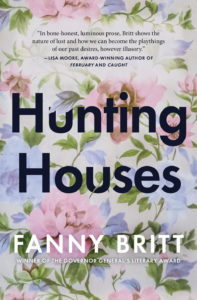 Here’s my true and somewhat embarrassing presumptuous confession: if I were a Governor-General’s Award-winning author, translator and playwright (with more than a dozen plays to my name) then Fanny Britt would totally be my Quebecois alter-ego. I started considering this idea when I published the non-fiction anthology The M Word: Conversations About Motherhood in 2014, and learned that the year before Britt had published an anthology of essays about motherhood called Les Trenchees, illustrated by Isabelle Arsenault—who had also illustrated Britt’s award-winning graphic novel, Jane, the Fox, and Me. I even bought an ebook version of Les Trenchees, although I can’t read French, but I figured if I wanted to read it hard enough I’d figure out how, although I never did. But no matter now, for Fanny Britt’s thoughts on womanhood and motherhood as expressed in her acclaimed novel Les maisons are now available as Hunting Houses, translated by Susan Ouriou and Christelle Morelli. A novel I read on the first two days of my holiday last week and loved completely, and also I hope there is a fictional world somewhere in which Britt’s protagonist Tessa and Sarah from my novel Mitzi Bytes are sitting in a kitchen having the most delicious gossip.
Here’s my true and somewhat embarrassing presumptuous confession: if I were a Governor-General’s Award-winning author, translator and playwright (with more than a dozen plays to my name) then Fanny Britt would totally be my Quebecois alter-ego. I started considering this idea when I published the non-fiction anthology The M Word: Conversations About Motherhood in 2014, and learned that the year before Britt had published an anthology of essays about motherhood called Les Trenchees, illustrated by Isabelle Arsenault—who had also illustrated Britt’s award-winning graphic novel, Jane, the Fox, and Me. I even bought an ebook version of Les Trenchees, although I can’t read French, but I figured if I wanted to read it hard enough I’d figure out how, although I never did. But no matter now, for Fanny Britt’s thoughts on womanhood and motherhood as expressed in her acclaimed novel Les maisons are now available as Hunting Houses, translated by Susan Ouriou and Christelle Morelli. A novel I read on the first two days of my holiday last week and loved completely, and also I hope there is a fictional world somewhere in which Britt’s protagonist Tessa and Sarah from my novel Mitzi Bytes are sitting in a kitchen having the most delicious gossip.
“There’s some solace in thinking your house will live on outside you, like an extension of yourself, a promise renewed no matter the trials or failures, bestowing sudden meaning on sorrow. Personally, I have a hard time swallowing the whole idea because I have no desire to see others blossom where I wilted—but then I’m not that nice a person.”
But then Britt is that kind of writer, I think. The writer who makes you feel as though you’re privy to some incredible intimacy, or even that she’s written her book with the most uncanny regard for the contents of your soul. I am sure I’m not the only reader who’s come away from Hunting Houses imagining that Britt and I have some kind of spiritual connection, that in some actual kitchen we could be terrific friends.
Anyway, it’s always a kitchen, right? Domestic realms. Kitchens and nurseries. Rooms matter, in particular because Hunting Houses’ Tessa is a real estate agent, an occupation that gives her curious access to other people’s lives. Although it’s in the laundry room where the story begins, where Tessa is being shown the house of a new client, Evelyne, whose selling her house due to divorce. “I don’t yet know that I’m at his house,” is the novel’s first sentence, he being Evelyne’s soon-to-be-ex, who Tessa encounters on a subsequent visit. An old flame of Tessa’s, a mostly unrequited seemingly inconsequential relationship, but one that arrives on the tail of adolescence and just before a jarring trauma, so that she never entirely gets over him, Francis. And then suddenly here he is all these years later, and the two of them make plans to meet.
Is she happy, Tessa, in her life? Selling houses becomes a metaphor for the hollowness at her core, a career she came to after a failure to become a professional singer, and then an early voyage into parenthood, which comes to define her. In a way it doesn’t to her husband, Jim, a trombonist, who has achieved a coveted job in an orchestra. But motherhood being not a full enough answer to the question of how a woman spends her time (as I write about in Mitzi Bytes; as Britt writes, “Is Tessa really going to spend the rest of her life working in a bookstore and having babies?”), Tessa requires something more, and so there is real estate. But there is also swimming lessons, and driving her children to school (and fitting awkward projects just-so into the trunk of her car), and Tessa is also in charge of the sweets on sale at her children’s school’s science fair.
“There’s the organizing committee and its numerous meetings, the first one usually held on a dark windy Wednesday November evening during which no one has anything to say about an event to held months later, but it’s the main source of social interaction for some parents, so I go (one out of every three times) since I don’t want to lose my kingdom.”
There is also Tessa’s best friend Sophie, who’s spent ages trying and failing to get pregnant, and memories of their youth together. And Tessa’s feelings about her life and about motherhood are further defined by her relationship to her own mother, which is complicated. Years before when Tessa was small, her mother took Tessa and her brother and fled her small town marriage and world for a single, free but hard scrabbling life in Montreal—and it’s interesting to read about motherhood from the perspectives of daughters whose mothers aren’t 1950s archetypes, a generation skipped. To be the daughter of a generation of women who made the breaks and took the chances, but learned that these kinds of risk aren’t necessarily the answer to every question. That life is much more complicated than that.
With shades of Virginia Woolf and Rachel Cusk in A Life’s Work and Arlington Park (but less annoying), Hunting Houses is the story of a few days in a life, and it also moves in and out of years. It’s a taut read and its momentum comes from Tessa’s voice and the surprising nature of her perspective, and also from the suspense of will-they-won’t-they as she prepares to meet with Francis again. It’s about the unflagging interestingness of other people’s lives and other people’s houses, and the lives we could possibly lead if we came unmoored from our own. “It was the blessed hour when lights go in houses and curtains have not yet been drawn.” Stories, like lit windows, illuminating countless other worlds.
June 28, 2017
Destination Bookshop: Creemore
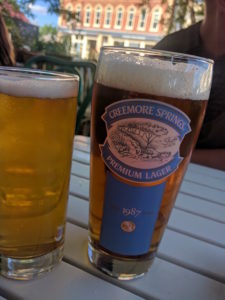 After spending part of Authors for Indies Day at Curiosity House Books in Creemore, ON, I knew I wanted to return there, and a quick visit to the nearby Cardboard Castles Toy Store that day clinched the town as a family road trip destination. A bookstore and a toy store? Everybody was going to be happy. And so for Saturday, which was my birthday, my family gave me the greatest gift of all, which was a day trip to the wilds of small town Ontario, where the beer and books were abundant and the sun shone all day long.
After spending part of Authors for Indies Day at Curiosity House Books in Creemore, ON, I knew I wanted to return there, and a quick visit to the nearby Cardboard Castles Toy Store that day clinched the town as a family road trip destination. A bookstore and a toy store? Everybody was going to be happy. And so for Saturday, which was my birthday, my family gave me the greatest gift of all, which was a day trip to the wilds of small town Ontario, where the beer and books were abundant and the sun shone all day long.
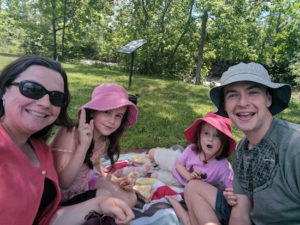 When we arrived in Creemore, we got a take-out lunch at the bakery and walked down to the park by the river to eat under a shady tree. We’d brought our picnic blanket and some frisbee toys, and partook in the pleasures of the great outdoors which was nice right after our car journey.
When we arrived in Creemore, we got a take-out lunch at the bakery and walked down to the park by the river to eat under a shady tree. We’d brought our picnic blanket and some frisbee toys, and partook in the pleasures of the great outdoors which was nice right after our car journey.
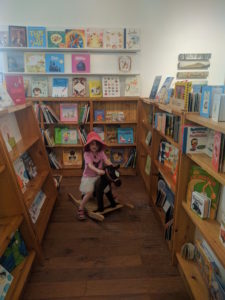 After lunch, we checked out Creemore’s main street and checked out the cool gift shops, art galleries, and the delicious food available at the 100 Mile Store, where we got chocolate and ice tea, and marvelled the local fishing flies and other wondrous things. And then next door was the bookshop, which was the reason for everything (but don’t tell anyone). Iris walked in and found a rocking horse, started riding it and exclaimed, “I’m having a very good time here.” Harriet went and asked the clerk if they had the new Fitzgerald-Trout book, and they did. Mitzi Bytes was on the shelf. The books I wanted to buy were in stock.
After lunch, we checked out Creemore’s main street and checked out the cool gift shops, art galleries, and the delicious food available at the 100 Mile Store, where we got chocolate and ice tea, and marvelled the local fishing flies and other wondrous things. And then next door was the bookshop, which was the reason for everything (but don’t tell anyone). Iris walked in and found a rocking horse, started riding it and exclaimed, “I’m having a very good time here.” Harriet went and asked the clerk if they had the new Fitzgerald-Trout book, and they did. Mitzi Bytes was on the shelf. The books I wanted to buy were in stock.
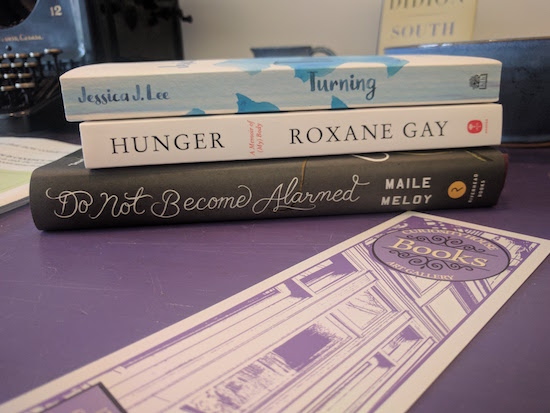
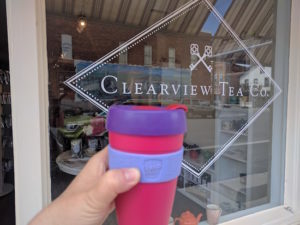 And then finally to the toy store, which is such a good toy store, and my kids found all kinds of cool stuff (and they have a discount clearance shelf that is honestly to die for). Next stop was the Clearview Tea Company, just around the corner, where we each got a cuppa, and I bought some Creemore Market Blend to take him and have been enjoying it ever since. (I also liked that she was was selling bouquets of fresh flowers, because the woman who own the flower shop next door had gone home to put her baby down for a nap.)
And then finally to the toy store, which is such a good toy store, and my kids found all kinds of cool stuff (and they have a discount clearance shelf that is honestly to die for). Next stop was the Clearview Tea Company, just around the corner, where we each got a cuppa, and I bought some Creemore Market Blend to take him and have been enjoying it ever since. (I also liked that she was was selling bouquets of fresh flowers, because the woman who own the flower shop next door had gone home to put her baby down for a nap.)
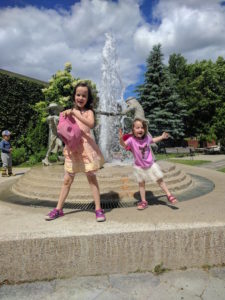 There is a small public garden across the road from the bookshop and we headed over there next to see what the growing and indulge in more grassy shade. (“Isn’t hanging out under a tree on the grass the most wonderful thing?” I asked Harriet. “Too bad it’s so expensive.”) The park features a sculpture of small children playing dress-up—too big shoes and capes—dancing in a ring around an actual fountain, which Harriet and Iris found quite delightful, particularly because when they danced around the fountain too they got wet. I was reading in the grass. All of us were pretty happy.
There is a small public garden across the road from the bookshop and we headed over there next to see what the growing and indulge in more grassy shade. (“Isn’t hanging out under a tree on the grass the most wonderful thing?” I asked Harriet. “Too bad it’s so expensive.”) The park features a sculpture of small children playing dress-up—too big shoes and capes—dancing in a ring around an actual fountain, which Harriet and Iris found quite delightful, particularly because when they danced around the fountain too they got wet. I was reading in the grass. All of us were pretty happy.
 We went to the brewery next, where we would have lingered longer, but the children were getting tired—but we still managed to sample some delicious Creemore beer. And then we headed to one more park, where there were climbers and they were amazing—but not before stopping off at the bakery for lemon tarts and cookies to sustain us.
We went to the brewery next, where we would have lingered longer, but the children were getting tired—but we still managed to sample some delicious Creemore beer. And then we headed to one more park, where there were climbers and they were amazing—but not before stopping off at the bakery for lemon tarts and cookies to sustain us.
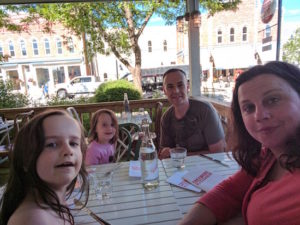 Dinner was at the Creemore Kitchen, where the fried chicken really was as good as they said. And then we headed back to the city as the gorgeous summer day turned into evening, and we were laden with books, our bellies were full, and the one member of our family who wasn’t happy proceeded to fall asleep within five minutes of being strapped into her carseat, and she slept blissfully all the way home.
Dinner was at the Creemore Kitchen, where the fried chicken really was as good as they said. And then we headed back to the city as the gorgeous summer day turned into evening, and we were laden with books, our bellies were full, and the one member of our family who wasn’t happy proceeded to fall asleep within five minutes of being strapped into her carseat, and she slept blissfully all the way home.
June 27, 2017
Boundary, by Andrée A. Michaud
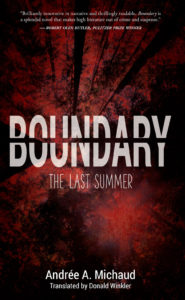 How about a book that checks all the boxes: an award winner (Governor General’s Award for French Fiction, and the Arthur Ellis Award), a gorgeous translation, a narrative with psychological depth, and a gripping thriller of the sort that summer reads are made of? I spent my weekend with Boundary, by Andrée A. Michaud, so perfectly steeped in summer and suspense, and I loved it—and I have been ardently recommending it to everybody for days now.
How about a book that checks all the boxes: an award winner (Governor General’s Award for French Fiction, and the Arthur Ellis Award), a gorgeous translation, a narrative with psychological depth, and a gripping thriller of the sort that summer reads are made of? I spent my weekend with Boundary, by Andrée A. Michaud, so perfectly steeped in summer and suspense, and I loved it—and I have been ardently recommending it to everybody for days now.
It’s set in a cottage community in Maine, a land that divides two nations, two languages. It becomes a place of in-between where anything is possible during the summer of 1967, the summer of love, the novel’s soundtrack playing Procol Harum and Lucy in the Sky With Diamonds. It’s a novel that’s also set on the border between girlhood and womanhood, two girls—Zaza and Sissy—on the cusp of everything. None of which will transpire, as both girls will be found dead that summer, caught by brutal animal traps hearkening back to the legendary woodsman Pete Landry, long ago found hanged his cabin and still said to haunt the woods. Are the girls deaths nothing more than tragic, stupid accidents, or is something (and someone) much more sinister at work?
If it weren’t already taken, Lives of Girls and Women would be an excellent alternative title for Boundary, which in its consideration of girlhood, friendship and violence, reminded me in the best way of Joni Murphy’s Double Teenage. While the novel is told from multiple perspectives, including from that of Detective Stan Michaud, its primary point of view belongs to young Andree Duchamp, who is young enough to escape much notice but also to notice everything—the exotic lives of the teenage girls, and also the experience of the wives and mothers in the community, who are its bedrock, and the ones who are left behind during the week when the husbands return to the city and whose stories are told with remarkable psychological acuity.
June 27, 2017
Four Great Activity Books For Summer
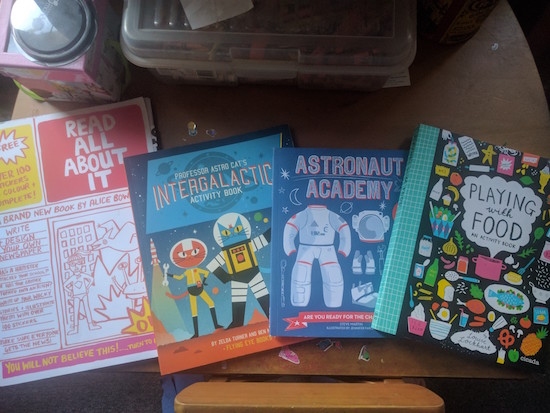
Today is my last day with both children in school, and while I have a million things to do in the scant amount of time I have left, I wanted to carve out a moment to recommend a few activity books we’ve loved this spring, and will be taking with us on vacation this summer to ease the waits in restaurants or to enliven rainy days.
Read All About It is a future journalist’s dream, a fun kit that lets kids put together their own newspaper headlines and stories using stickers, the more bizarre the stories the better.
Professor Intergalactic Cat’s Activity Book is based on the gorgeously illustrated science books by Ben Newman and is packed with games and experiments for kids who are curious about the world around them (and even the worlds beyond!).
And speaking of worlds beyond, we love Astronaut Academy, a fun book for the poor children who can’t make it to Space Camp this summer, containing fun and challenging activities to prepare future astronauts for an experience in space.
And finally Playing With Food, by Louise Lockhart, which is my favourite colouring book ever (the FUN of colouring a vintage kitchen, or choosing colours for a page full of mystery beverages) and a treasure for children of any age who are partial to yummy things and great design.
June 26, 2017
Mitzi Bytes in the World
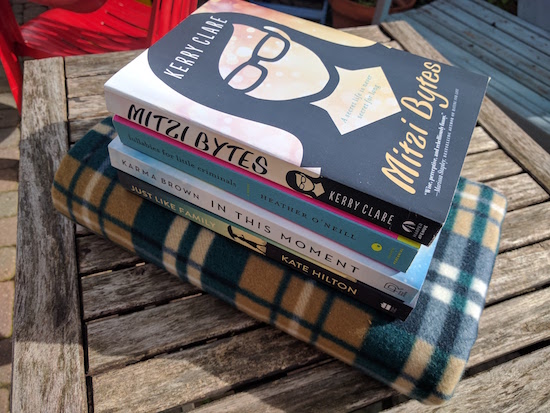
A very nice thing is that #MitziInTheSun kicked off last week and lots of people shared the image or shared their own sunny Mitzi shots (because my hashtag would have been lonely otherwise…): Mitzi by the lake, at the ballgame, in London, even! The photo above is of the excellent #MitziInTheSun summer reading prize pack, which could be yours if you play the game (which runs until the end of July).
Other good things: Mitzi Bytes was featured on Plenty in May: “a clever page-turner of a novel with a powerful engine of a plot, some of the funniest dialogue you will ever read, and a sex scene with a ventriloquist.” Dawn Dumont was kind enough to include it on her summer reading list for The Writers’ Trust of Canada in very good company. And Matilda Magtree had very nice things to say about the book as well when SHE DID NOT REVIEW IT recently.
And now coming up? I’m going to be reading at Lexicon Books in Lunenburg, NS, next Friday, July 6, reading with Johanna Skibsrud and Rebecca Silver Slayter. And the weekend after that, I’ll be at the Lakefield Literary Festival, appearing with Zoe Whittall and Marni Jackson on Friday, July 14 and teaching my blogging workshop the next morning. Hope to see you there!
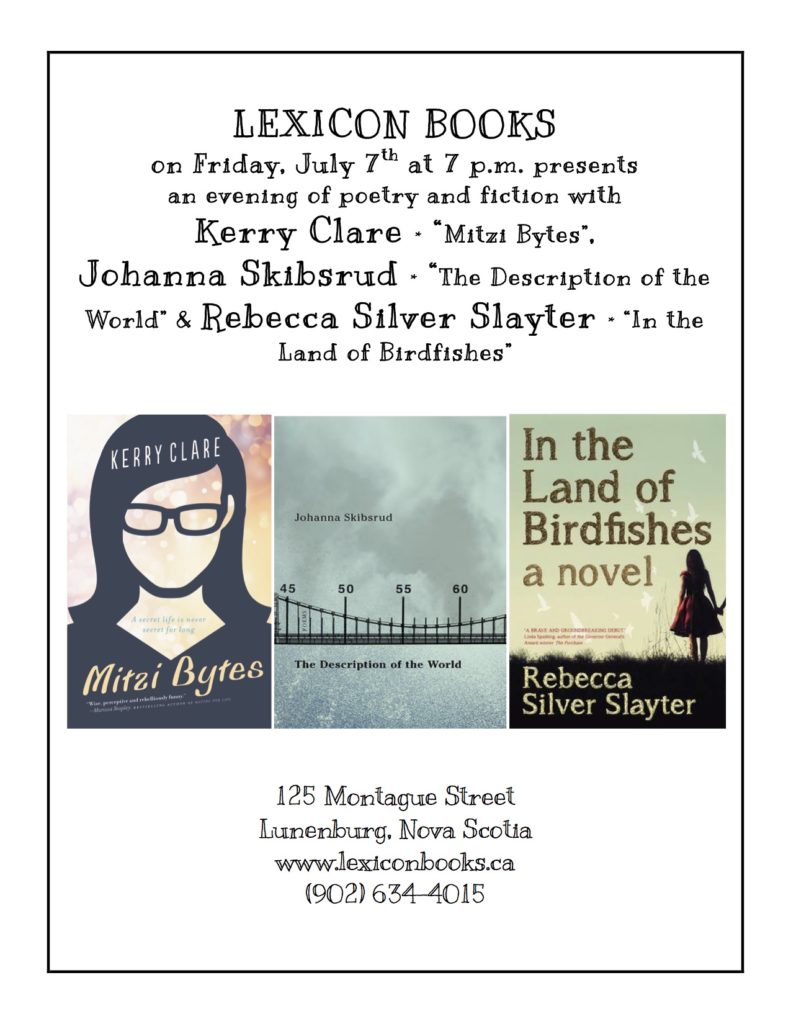
June 23, 2017
Rosie and Michael, by Judith Viorst and Lorna Tomei
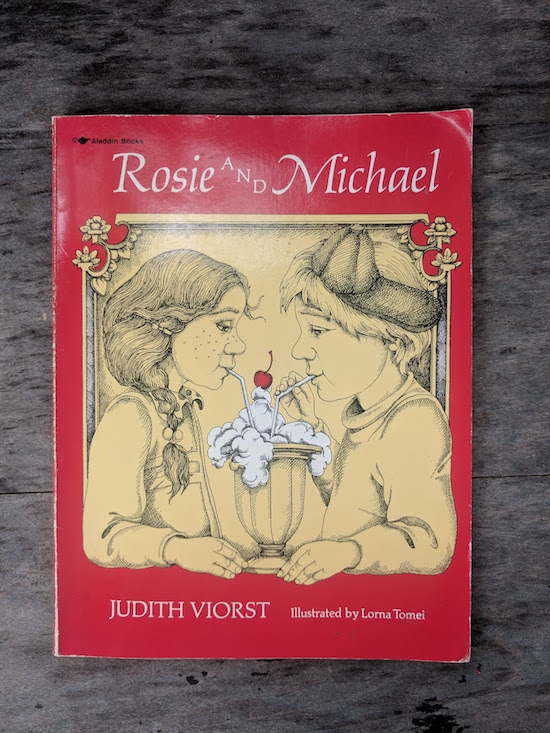
I’ve spent this week finishing up the second draft of my new novel, whose title at the moment is I Wish It Were Tomorrow. That title is actually the last line of The Hating Book, by Charlotte Zolotow (and if this title remains and my book is published, this will make for me two-for-two for novels inspired by works edited by Ursula Nordstrom). The Hating Book, like my novel, is a story of the complicated nature of friendship, about friendship’s necessary flip-side, which isn’t the opposite of friendship, exactly, but simply part of it. To expect to lines to run strictly parallel forever and ever is an awfully high expectation. And even when the course of a friendship does run smooth, things can be complicated. It is to one’s friends that one is not always the kindest. And it is that way that friends are like family.
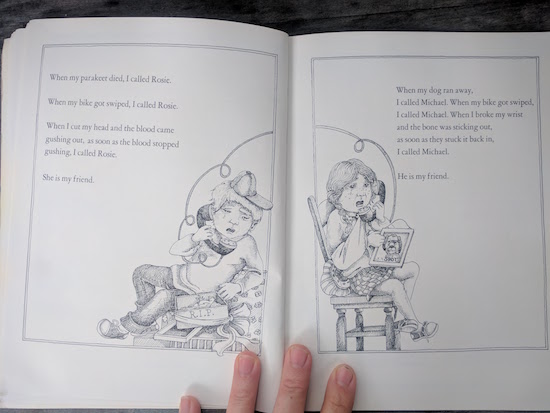
Rosie and Michael, by Judith Viorst and illustrated by Lorna Tomei, first published in 1974, was not a book I was familiar with until Harriet’s class recited it in their school’s spring concert last month. Harriet’s line was, “I worry a lot about werewolves, and he understands.” And oh, is there anybody else who can illustrate the full spectrum of human experience—the good, the bad and the awful—as well as Viorst, author of classics such as Alexander and the No Good Very Bad Day and I’ll Fix Anthony? She gets the quiet rage of childhood fury better than anyone, and can frame it within a context of love and security, which isn’t easy. Judith Viorst would know that friendships can be complicated: “Just because I put a worm in his tuna salad sandwich doesn’t mean that Michael’s not my friend.” Exactly.
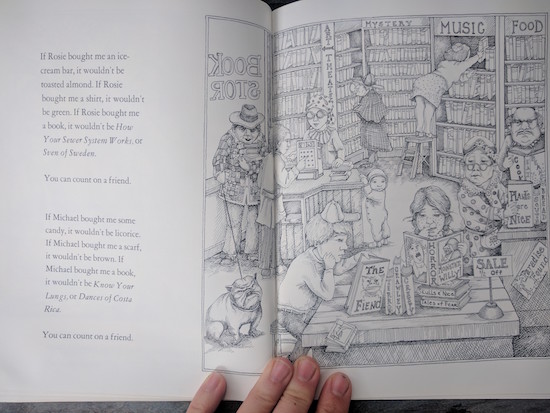
We are coming up to the end of a very good school year for both children, and a more difficult ending than we had the previous year in which both Harriet and Iris were returning to the same teachers. Iris’s teacher, the inimitable Tracey at playschool, who introduced the concept of “friendliness” into our lives in a way we hadn’t experienced before. Why don’t we hit, bite, stomp through people’s gardens and act out when we are cranky? Because it’s not very friendly, Tracey has taught us, along with the idea that friendliness is a way of being in the world, a general level of approachability, giving other people a break, giving other people space, even. To be friendly is to reach out to somebody in need, to give a hug to somebody who is sad, to smile at a stranger, to pick up litter in the park, to hold a little kid’s hand firmly when the little kid is crossing the street. A lot of it is about taking responsibility for one’s own actions. A lot of it is about being kind.
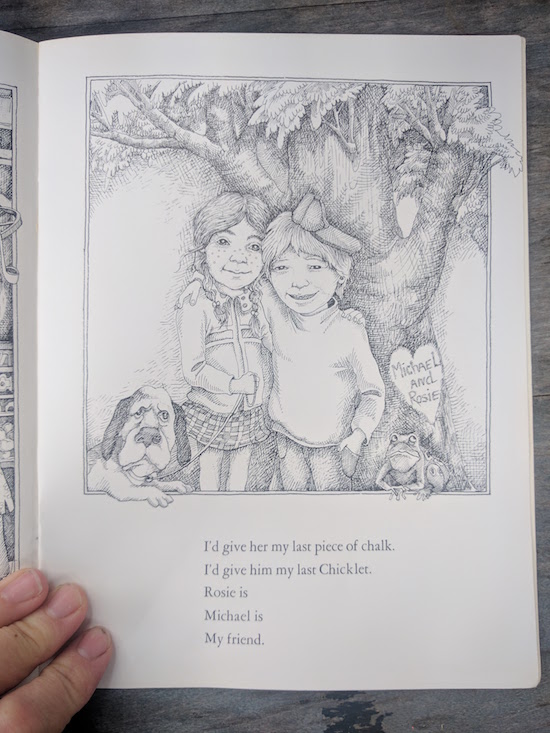
Harriet in grade two has had similar yet, appropriately, more advanced lessons about friendliness and friendship in her class over the past two years. Her teacher, Ms. T, has subtly and yet powerfully gone to great lengths to nurture a sense of community in her classroom and sense of responsibility toward the wellbeing of others. I will miss the unique dynamic she has created in her class, which has made for such a positive experience socially for Harriet, who has learned about appreciating difference and finding what’s in common, about working together and supporting each other. The children in her class seem to be inclusive and welcoming, playing together, letting quirky kids be quirky and appreciating those quirks—Harriet’s classmates have been incredibly avid in supporting her hedgehog obsession, for instance. The class is united as a group, and doesn’t become divided along gender lines, and I’m so grateful for the friendships Harriet has been able to have with the boys in class. They’re an incredible group of unique and funny personalities, and part of that is why they work the way do, but so much more is also because of the deliberate approach of her teacher.
All this occurred to me at the spring concert as I listened to then reading Rosie and Michael, what a perfect story is this for this group, this celebration of friendship’s elasticity and solidity at once, and how these relationships become the foundation of the people we are. And it occurred to me too that I have a lot more work to do on my novel, to get at the nuance, amazing singularly, friction, synchronicity, and care involved in sharing a friendship over many years. But still, I’m getting closer.
June 21, 2017
Places I’ve Gone With A Book in My Bag
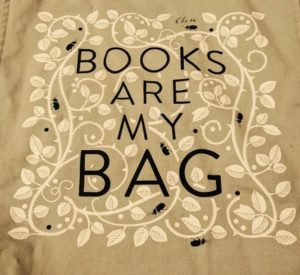
- Our neighbours’ backyard party last Saturday evening. This was the event that occasioned this list, as it made me consider whether I might actually have a book-in-the-bag problem. I was definitely not intending to read at this thoroughly enjoyable social event (and I didn’t) but when I considered the slight prospect of one of my children having to go the hospital (perhaps after falling out of a tree?) and a five hour wait in the ER waiting room, not bringing a book just seemed dangerous.
- Hospital waiting rooms: Oh, the splendid hours I’ve been reading in such places. The best ever was when Harriet poked me in the eye during a heat wave in August 2010* and I left our sweltering apartment to spend hours and hours in air conditioned splendour, rereading Slouching Toward Bethlehem for the zillionth time and waiting for the doctor to tell me that I would not be going blind. *Note that I have all the details on this matter because I wrote a blog post extolling the virtues of waiting rooms as places to read back when I had a one-year-old and life was harder.
- The park. Always, in the park. My worst nightmare, in fact, is not of anything involving hospital waiting rooms, but instead the prospect of a sunny day where my children don’t want to go home but I’ve got nothing to read save for the organ donor card in my wallet (and I’ve already read that). I will never forget the summer day when Harriet was two and I spent a whole afternoon sprawled in the backseat of the climbing frame that resembles a jeep at Huron Washington Playground reading the entirety of Alice Thomas Ellis’s novel The 27th Kingdom while Harriet pretended to “drive.”
- Out for lunch. Sometimes because the book is to be my lunch companion (oh, and what a joy is that!) and even if my companion is to be actual human being, a book in your bag means you can read while she goes to the bathroom.
- On the subway. First, because the subway is a very good place to read, but also because what if your subway car gets stuck in a tunnel for three hours? How would you bear it without a book to read?
- The Bookstore. This is where it gets really stupid. I always have a book in my bag, but half the time the only place I ever go to is a bookstore anyway. But still, if I went to a bookstore without a book in my bag, I’d have nothing to read in transit. And think about if the subway got stuck in the tunnel, right?? But then, what if you were fifteen pages away from the end of a book? This is when things get complicated. Because you need to bring a secondary book to start reading when you finish the first one, and perhaps a tertiary book just in case that second title turns out to be a bit of a dud. I could possibly come up with a very good reason why you should never go to a bookstore without thirty-seven novels in your rucksack. Anything less would be reckless.
- Harriet’s birthday party. We took eight small girls to the movies. Sadly, I didn’t get a chance to read at all.
- Playschool co-op shifts. I don’t know why I ever thought I’d have the chance to read on a playschool co-op shift, particularly since I never ever have. But still, you don’t want to take a chance like that.
- The Shovels and Rope concert at the Phoenix in October: I was reading Ann Patchett’s Commonwealth before the show while Stuart was in the loo. The security guard who checked my bag thought it was weird that I had a book.
- My own book launch. I was reading Big Little Lies. I didn’t get a chance to read it though.
- The hospital, where I gave birth to my second child. This is not so weird, but it is weird when you consider that I brought nothing else except for a pair of shoes to wear in the shower. I was hoping to give birth at home, and perhaps thought packing clothes would jinx this. Instead, it just meant I spent a lot of time naked. But at least I had a book.





